Typhoon Effect on Kuroshio and Green Island Wakes: A Modelling Study
Abstract
:1. Introduction
2. Theory and Numerical Method
2.1. Shallow-Water Equations
2.2. Space-Time Least-Squares Finite-Element Method
3. Computed Results and Discussion
3.1. Typhoon Soulik
3.2. Effect of Model Typhoon on Green Island Wakes
4. Conclusions
Acknowledgments
Author Contributions
Conflicts of Interest
References
- Zdravkovich, M.M. Flow around Circular Cylinders; Applications, Oxford University Press: Oxford, UK, 2003; Volume 2, ISBN 9780198565611. [Google Scholar]
- Chelton, D.B.; Schlax, M.G.; Samelson, R.M. Global observations of nonlinearmesoscale eddies. Prog. Oceanogr. 2011, 91, 167–216. [Google Scholar] [CrossRef]
- Nunalee, C.G.; Basu, S. On the periodicity of atmospheric von Kármán vortex streets. Environ. Fluid Mech. 2014, 14, 1335–1355. [Google Scholar] [CrossRef]
- Roshko, A. On the wake and drag of bluff bodies. J. Aeronaut. Sci. 1955, 22, 124–132. [Google Scholar] [CrossRef]
- Tritton, D.J. Experiments on the flow past a circular cylinder at low Reynolds numbers. J. Fluid Mech. 1959, 6, 547–567. [Google Scholar] [CrossRef]
- Williamson, C.H. Vortex dynamics in the cylinder wake. Annu. Rev. Fluid Mech. 1996, 28, 477–539. [Google Scholar] [CrossRef]
- Hubert, L.; Krueger, A. Satellite pictures of mesoscale eddies. Mon. Weather Rev. 1962, 90, 457–463. [Google Scholar] [CrossRef]
- Li, X.; Clemente-Colón, P.; Pichel, W.G.; Vachon, P.W. Atmospheric vortex streets ona RADARSAT SAR image. Geophys. Res. Lett. 2000, 27, 1655–1658. [Google Scholar] [CrossRef]
- Thomson, R.E.; Gower, J.F.; Bowker, N.W. Vortex streets in the wake of the AleutianIslands. Mon. Weather Rev. 1977, 105, 873–884. [Google Scholar] [CrossRef]
- Young, G.S.; Zawislak, J. An observational study of vortex spacing in island wake vortexstreets. Mon. Weather Rev. 2006, 134, 2285–2294. [Google Scholar] [CrossRef]
- Zheng, Q.; Lin, H.; Meng, J.; Hu, X.; Song, Y.T.; Zhang, Y.; Li, C. Submesoscale oceanvortex trains in the Luzon Strait. J. Geophys. Res. Oceans 2008, 113, C0403-1–C04032-12. [Google Scholar] [CrossRef]
- Barkley, R.A. Johnston atolls wake. J. Mar. Res. 1972, 30, 201–216. [Google Scholar]
- Dong, C.; McWilliams, J.C.; Shchepetkin, A.F. Island wakes in deep water. J. Phys. Oceanogr. 2007, 37, 962–981. [Google Scholar] [CrossRef]
- Heywood, K.J.; Stevens, D.P.; Bigg, G.R. Eddy formation behind the tropical island ofAldabra. Deep-Sea Res. Part I 1996, 43, 555–578. [Google Scholar] [CrossRef] [Green Version]
- Ruscher, P.H.; Deardorff, J.W. A numerical simulation of an atmospheric vortex street. Tellus A 1982, 34, 555–566. [Google Scholar] [CrossRef]
- Wolanski, E.; Imberger, J.; Heron, M. Island wakes in shallow coastal waters. J. Geophys. Res. Oceans 1984, 89, 10553–10569. [Google Scholar] [CrossRef]
- Chang, M.H.; Tang, T.Y.; Ho, C.R.; Chao, S.Y. Kuroshioinduced wake in the lee of GreenIsland off Taiwan. J. Geophys. Res. Oceans 2013, 118, 1508–1519. [Google Scholar] [CrossRef]
- Hsin, Y.C.; Wu, C.R.; Shaw, P.T. Spatial and temporal variations of the Kuroshio east ofTaiwan, 1982–2005: A numerical study. J. Geophys. Res. Oceans 2008, 113, C04002-1–C04002-15. [Google Scholar] [CrossRef]
- Liang, S.J.; Lin, C.Y.; Hsu, T.W.; Ho, C.R.; Chang, M.H. Numerical study of vortexcharacteristics near Green Island, Taiwan. J. Coast. Res. 2013, 29, 1436–1444. [Google Scholar] [CrossRef]
- Gunduz, M.; Özsoy, E. Modelling seasonal circulation and thermohaline structure of the Caspian Sea. Ocean Sci. 2014, 10, 459–471. [Google Scholar] [CrossRef]
- Suda, K. The Science of the Sea (Kaiyo-Kagaku); Kokin-Shoin: Tokyo, Japan, 1943. [Google Scholar]
- Sun, L.; Yang, Y.J.; Fu, Y.F. Impacts of typhoons on the Kuroshio large meander: Observationevidences. Atmos. Ocean. Sci. 2009, 2, 45–50. [Google Scholar] [CrossRef]
- Chen, C.T.A.; Liu, C.T.; Chuang, W.; Yang, Y.; Shiah, F.K.; Tang, T.; Chung, S. Enhancedbuoyancy and hence upwelling of subsurface Kuroshio waters after a typhoon in the southern East China Sea. J. Mar. Syst. 2003, 42, 65–79. [Google Scholar] [CrossRef]
- Chen, F. The Kuroshio Power Plant, The Kuroshio Power Plant; Springer: Singapore, 2013; ISBN 978-3-319-00822-6. [Google Scholar]
- Hsu, T.W.; Doong, D.J.; Hsieh, K.J.; Liang, S.J. Numerical study of Monsoon effecton Green Island Wake. J. Coast. Res. 2015, 31, 1141–1150. [Google Scholar] [CrossRef]
- Liu, K.K.; Gong, G.C.; Shyu, C.Z.; Pai, S.C.; Wei, C.L.; Chao, S.Y. Response of Kuroshioupwelling to the onset of the northeast monsoon in the sea north of Taiwan: Observations anda numerical simulation. J. Geophys. Res. Oceans 1992, 97, 12511–12526. [Google Scholar] [CrossRef]
- Buachart, C.; Kanok-Nukulchai, W.; Ortega, E.; Onate, E. A shallow watermodel by finite point method. Int. J. Comput. Meth. 2014, 11, 1350047-1–1350047-27. [Google Scholar] [CrossRef]
- Johnson, R. A Modern Introduction to the Mathematical Theory of Water Waves; Cambridge University Press: Cambridge, UK, 1997. [Google Scholar]
- Tan, W.Y. Shallow Water Hydrodynamics: Mathematical Theory and Numerical Solution fora Two-Dimensional System of Shallow-Water Equations; Elsevier: Singapore, 1992; ISBN 9780080870939. [Google Scholar]
- Vreugdenhil, C.B. Numerical Methods for Shallow-Water Flow; Springer Science & BusinessMedia: Singapore, 2013. [Google Scholar]
- Toro, E.F. Riemann Solvers and Numerical Methods for Fluid Dynamics; A Practical Introduction; Springer: New York, NY, USA, 1999. [Google Scholar]
- Toro, E.F. Shock-Capturing Methods for Free-Surface Shallow Flows; John Wiley & Sons: New York, NY, USA, 2001. [Google Scholar]
- Yulistiyanto, B.; Zech, Y.; Graf, W. Flow around a cylinder: Shallow-water modeling withdiffusion-dispersion. J. Hydraul. Eng. ASCE 1998, 124, 419–429. [Google Scholar] [CrossRef]
- Martin, J.L.; McCutcheon, S.C. Hydrodynamics and Transport for Water Quality Modeling; CRC Press: Boca Raton, FL, USA, 1998; ISBN 9780873716123. [Google Scholar]
- Holland, G.J.; Belanger, J.I.; Fritz, A. A revised model for radial profiles of hurricanewinds. Mon. Weather Rev. 2010, 138, 4393–4401. [Google Scholar] [CrossRef]
- Powell, M.D. Evaluations of diagnostic marine boundary-layer models applied to hurricanes. Mon. Weather Rev. 1980, 108, 757–766. [Google Scholar] [CrossRef]
- Zhang, H.; Sannasiraj, S. Wind wave effects on surface stress in hydrodynamic modeling. In Proceedings of the Eighth ISOPE Pacific/Asia Offshore Mechanics Symposium, Bangkok, Thailand, 10–14 November 2008; International Society of Offshore and Polar Engineers: Vancouver, BC, Canada, 2008. [Google Scholar]
- Gunzburger, M.D. Finite Element Methods for Viscous Incompressible Flows: A Guide to Theory; Practice, and Algorithms; Elsevier: Singapore, 2012; ISBN 9780323139823. [Google Scholar]
- Hughes, T.J.; Hulbert, G.M. Space-time finite element methods for elastodynamics: Formulationsand error estimates. Comput. Methods Appl. Mech. 1988, 66, 339–363. [Google Scholar] [CrossRef]
- Jiang, B.N. The Least-Squares Finite Element Method: Theory and Applications in Computational Fluid Dynamics and Electromagnetics; Springer Science & Business Media: Berlin, Germany, 1998; ISBN 978-3-662-03740-9. [Google Scholar]
- Laible, J.P.; Pinder, G.F. Solution of the shallow water equations by least squares collocation. Water Resour. Res. 1993, 29, 445–455. [Google Scholar] [CrossRef]
- Liang, S.J.; Hsu, T.W. Least-squares finite-element method for shallow-water equationswith source terms. Acta Mech. Sin. 2009, 25, 597–610. [Google Scholar] [CrossRef]
- Zheng, Z.W.; Zheng, Q. Variability of island-induced ocean vortex trains, in the Kuroshioregion southeast of Taiwan Island. Cont. Shelf Res. 2014, 81, 1–6. [Google Scholar] [CrossRef]
- Shepard, D. A two-dimensional interpolation function for irregularly-spaced data. In Proceedings of the 23rd ACM National Conference, New York, NY, USA, 27–29 August 1968; pp. 517–524. [Google Scholar]
- Lu, Y.C.; Liau, J.M.; Ou, S.H.; Lai, J.W.; Chou, M.H.; Hsu, T.W. Effects of typhoon onKuroshio current field. In Proceedings of the 7th Chinese-German Joint Symposium on Hydraulic and OceanEngineering, Leibniz Universitat Hannover, Hanover, Germany, 8–12 September 2014. [Google Scholar]
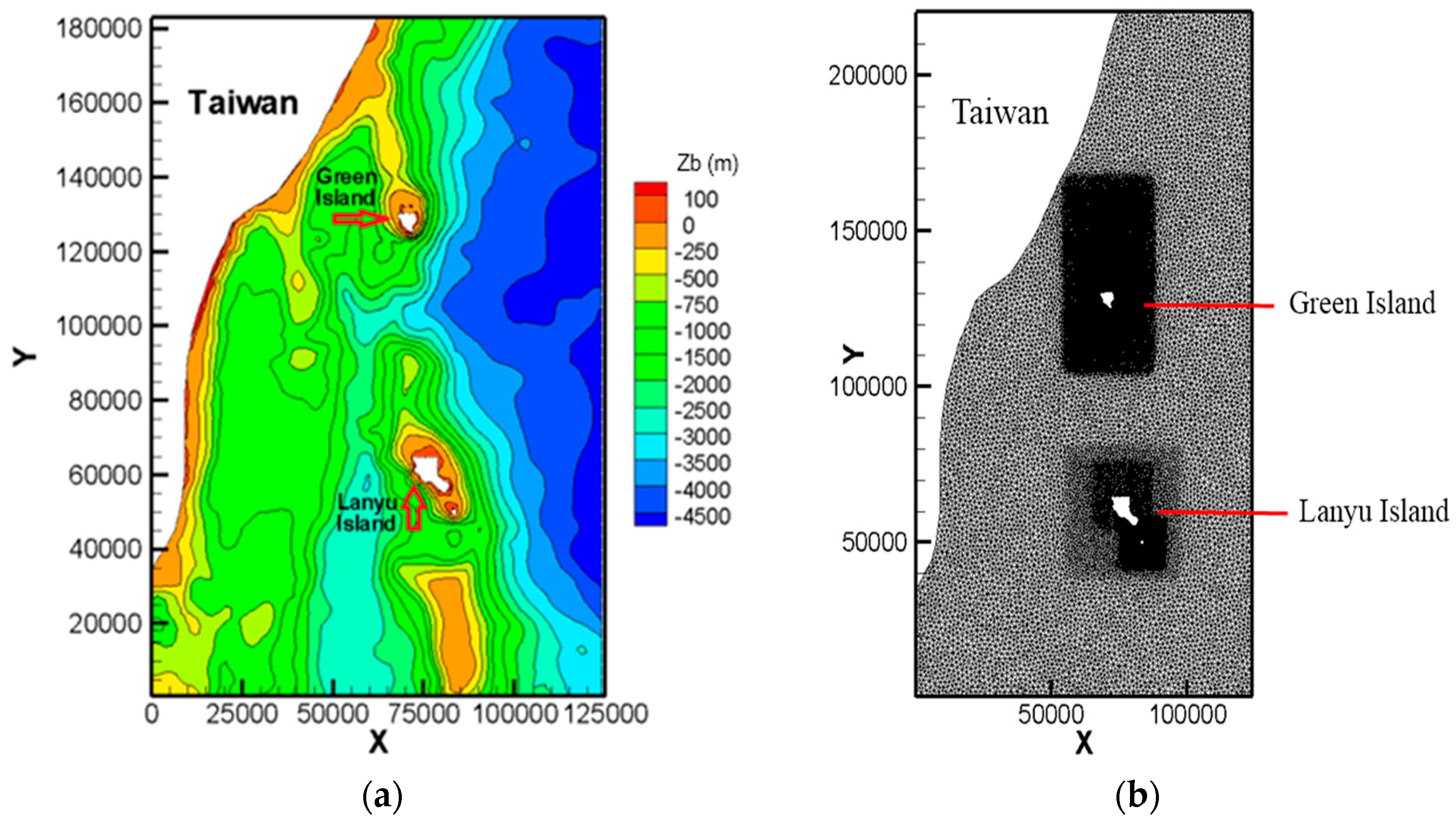
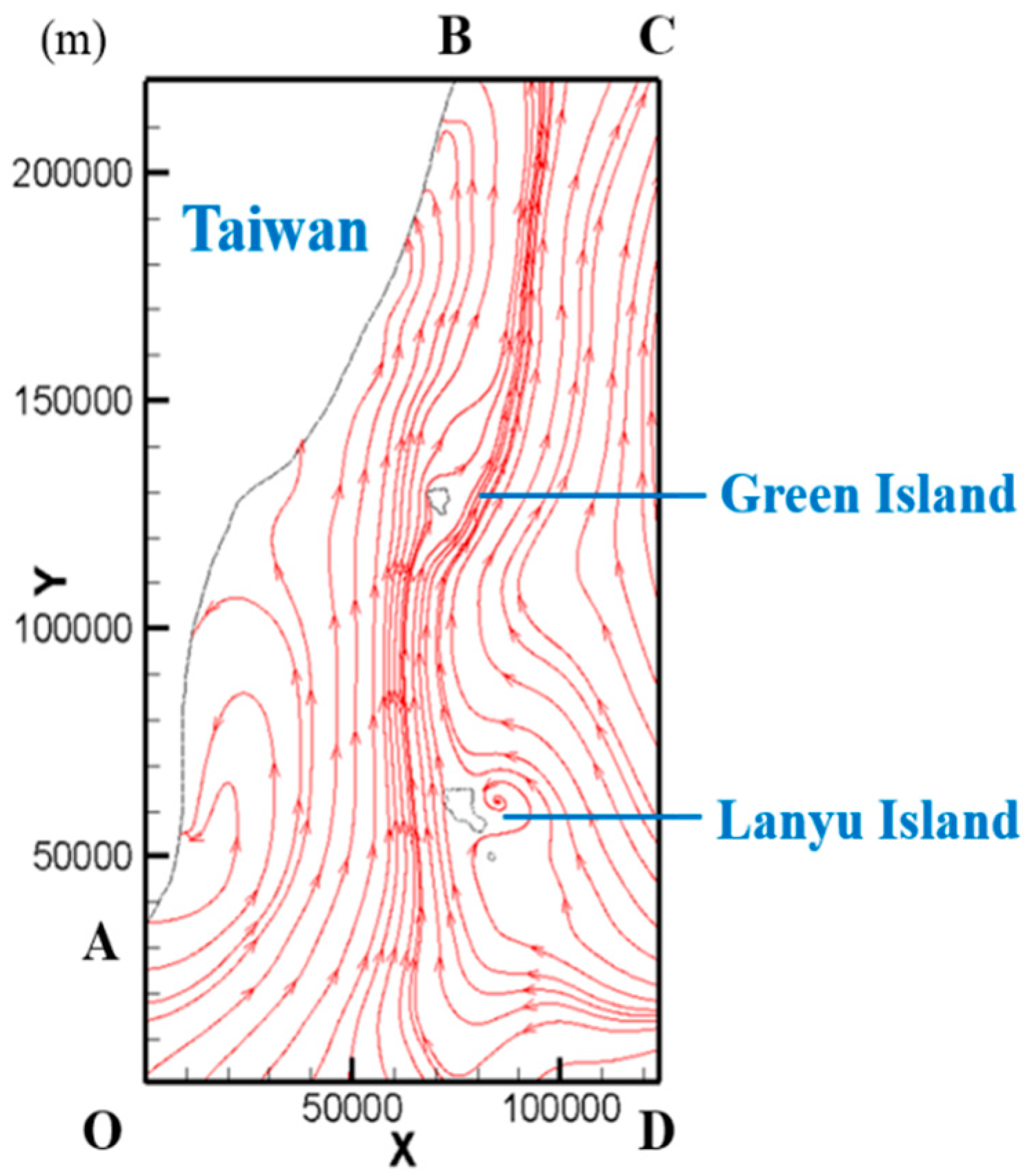
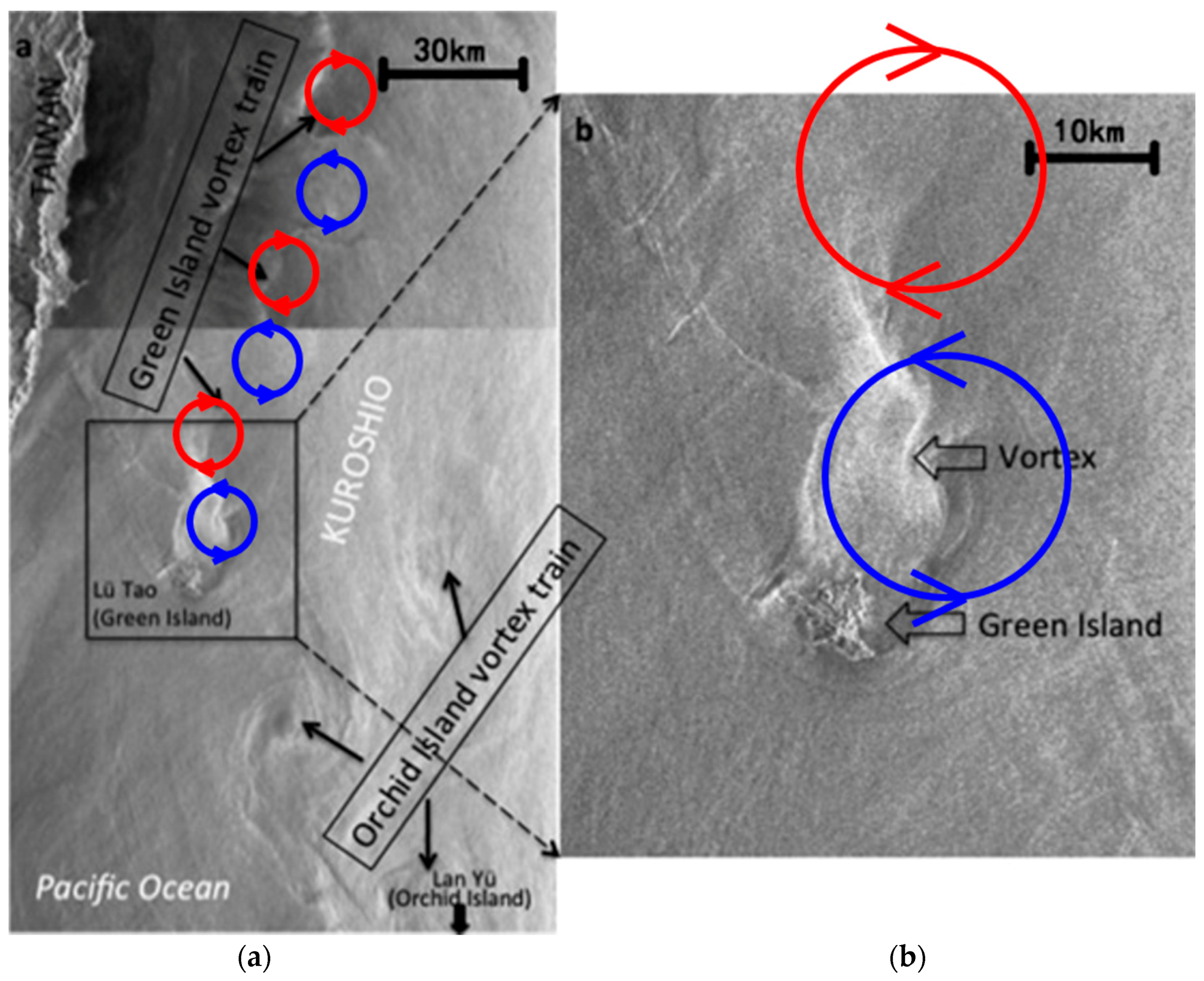
 denotes the tropical depression with maximum wind speed Vmax < 17.2 m/s;
denotes the tropical depression with maximum wind speed Vmax < 17.2 m/s;  the tropical storm, 17.2 m/s < Vmax < 32.6 m/s;
the tropical storm, 17.2 m/s < Vmax < 32.6 m/s;  the moderate typhoon, 32.7 m/s < Vmax < 50.9 m/s;
the moderate typhoon, 32.7 m/s < Vmax < 50.9 m/s;  a severe typhoon, 51 m/s < Vmax, and S0–S4 are the five time instances with a 12 h of increment to show the flow fields, see Figure 6, for example, S0 represents 00:00 of 12 July, S1 12:00 of 12 July, S2 00:00 of 13 July, S3 12:00 of 13 July and S4 00:00 of 14 July 2013, respectively. (Modified from CWB of Taiwan).
a severe typhoon, 51 m/s < Vmax, and S0–S4 are the five time instances with a 12 h of increment to show the flow fields, see Figure 6, for example, S0 represents 00:00 of 12 July, S1 12:00 of 12 July, S2 00:00 of 13 July, S3 12:00 of 13 July and S4 00:00 of 14 July 2013, respectively. (Modified from CWB of Taiwan).
 denotes the tropical depression with maximum wind speed Vmax < 17.2 m/s;
denotes the tropical depression with maximum wind speed Vmax < 17.2 m/s;  the tropical storm, 17.2 m/s < Vmax < 32.6 m/s;
the tropical storm, 17.2 m/s < Vmax < 32.6 m/s;  the moderate typhoon, 32.7 m/s < Vmax < 50.9 m/s;
the moderate typhoon, 32.7 m/s < Vmax < 50.9 m/s;  a severe typhoon, 51 m/s < Vmax, and S0–S4 are the five time instances with a 12 h of increment to show the flow fields, see Figure 6, for example, S0 represents 00:00 of 12 July, S1 12:00 of 12 July, S2 00:00 of 13 July, S3 12:00 of 13 July and S4 00:00 of 14 July 2013, respectively. (Modified from CWB of Taiwan).
a severe typhoon, 51 m/s < Vmax, and S0–S4 are the five time instances with a 12 h of increment to show the flow fields, see Figure 6, for example, S0 represents 00:00 of 12 July, S1 12:00 of 12 July, S2 00:00 of 13 July, S3 12:00 of 13 July and S4 00:00 of 14 July 2013, respectively. (Modified from CWB of Taiwan).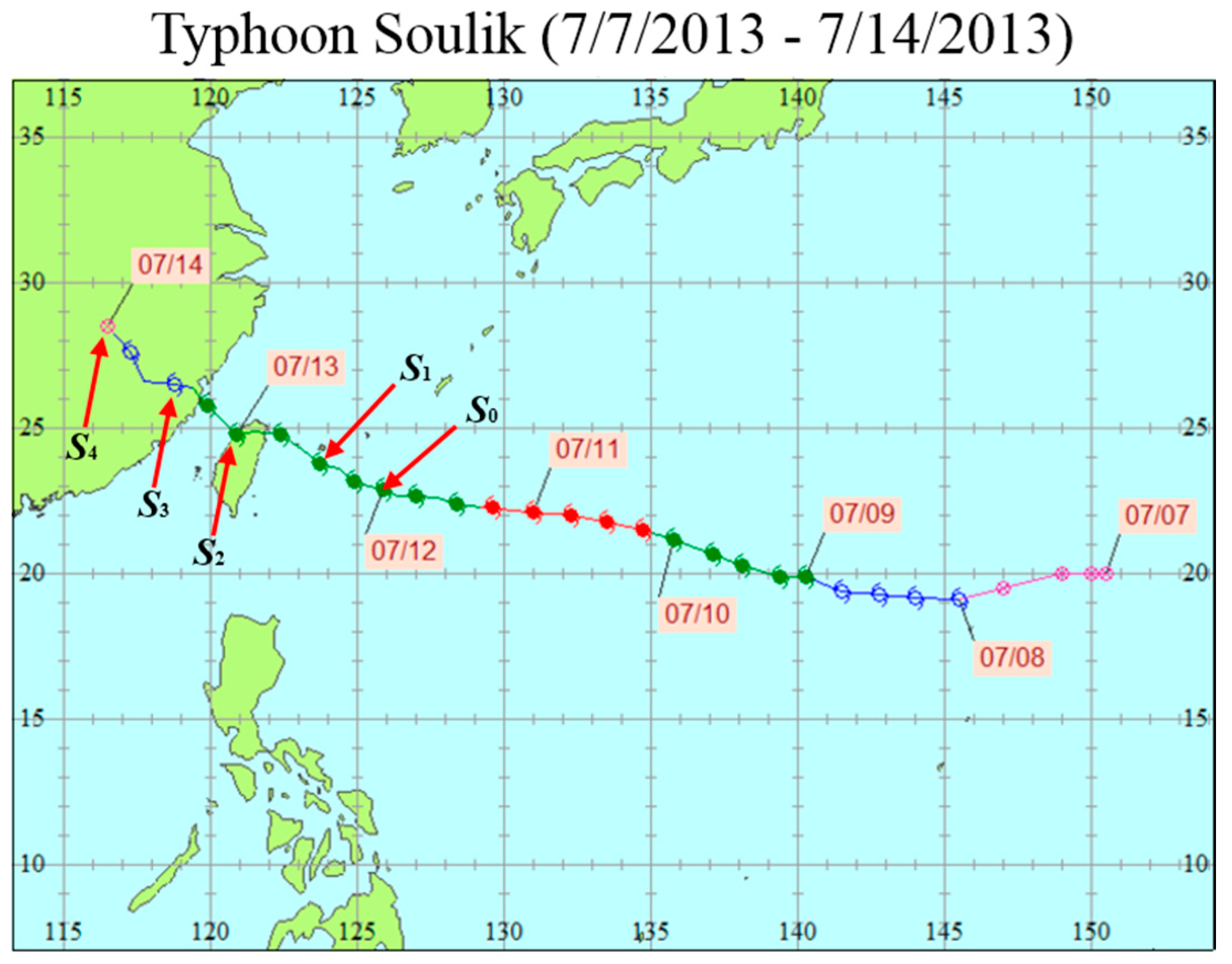

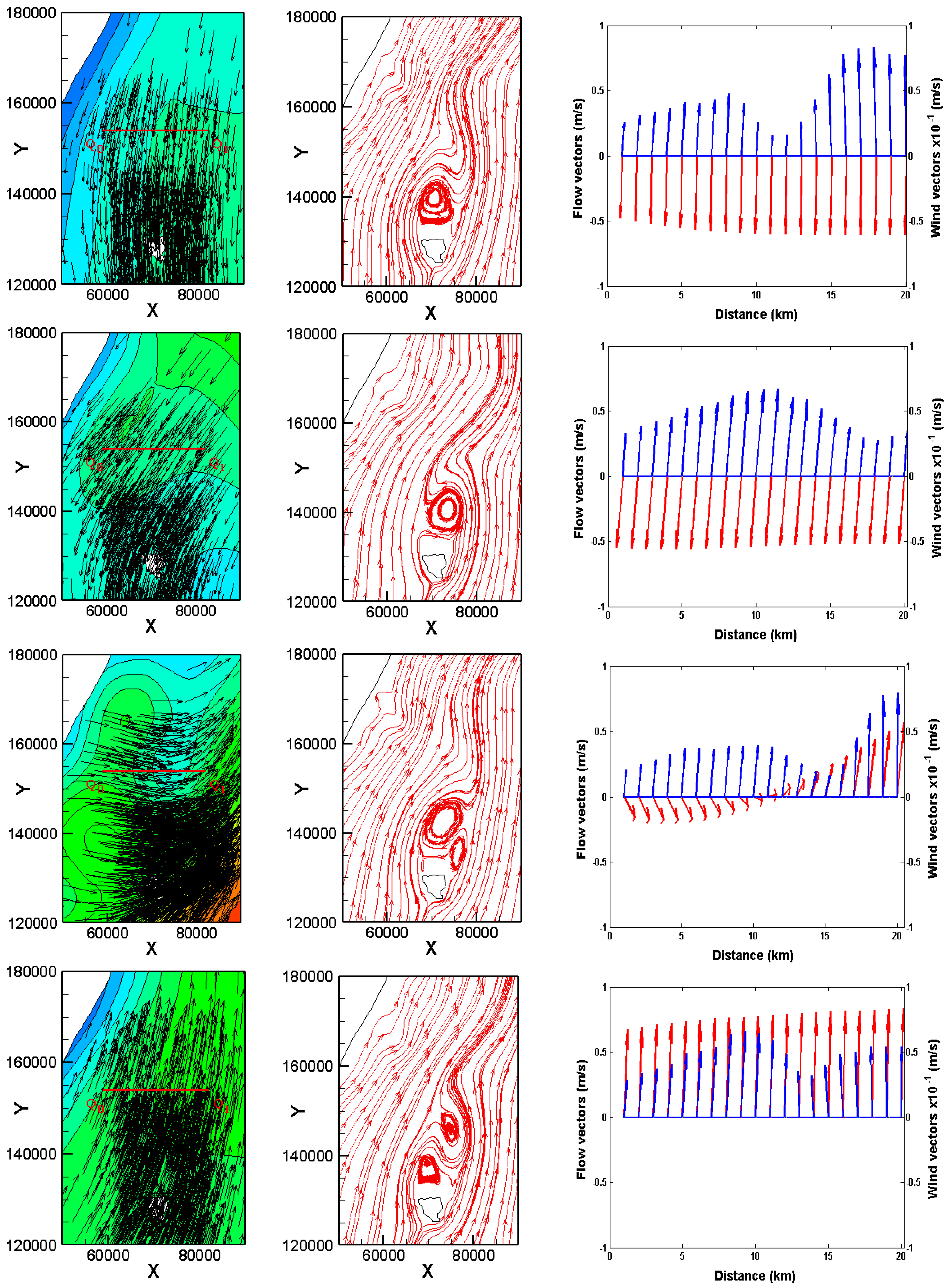

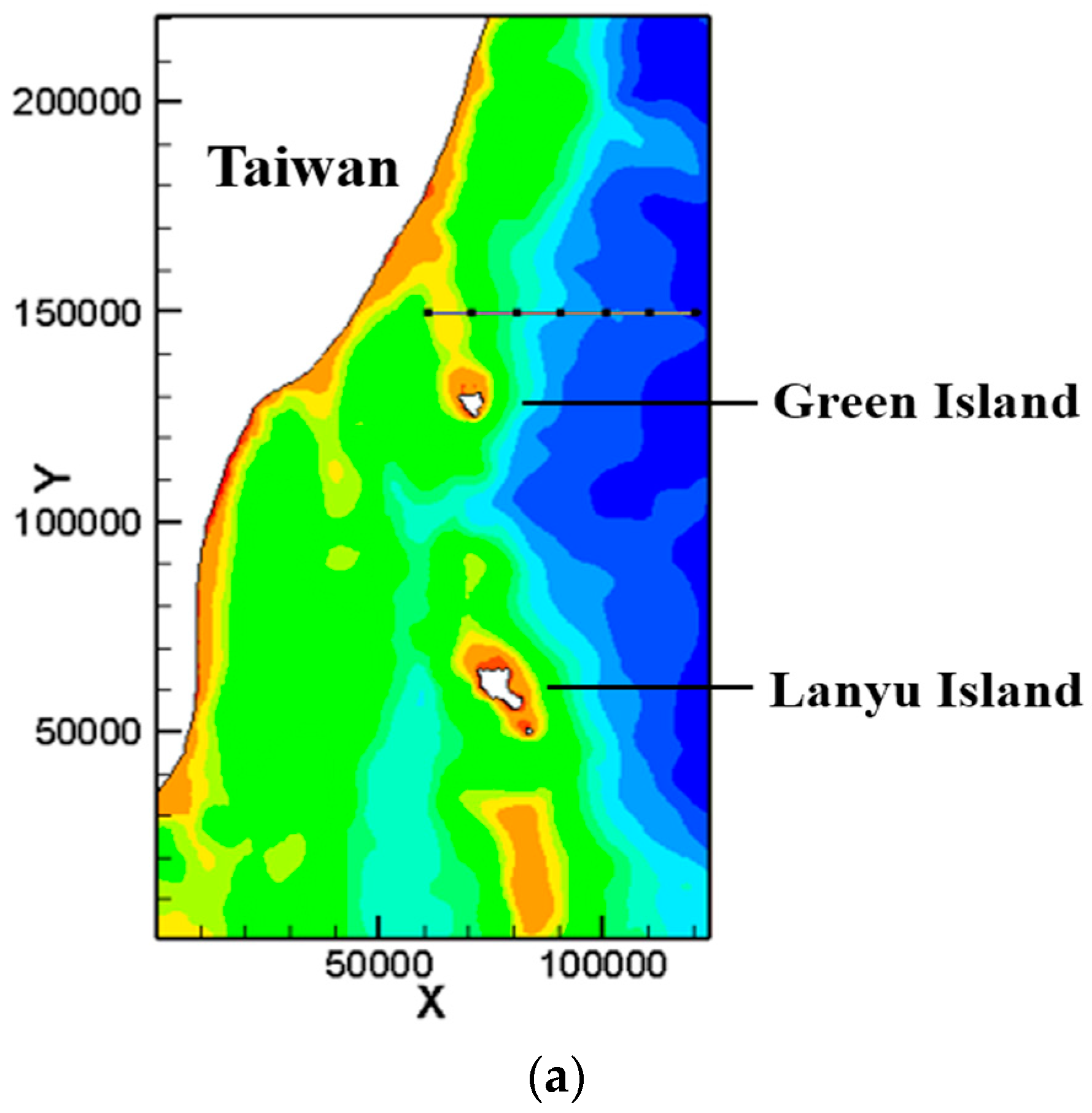

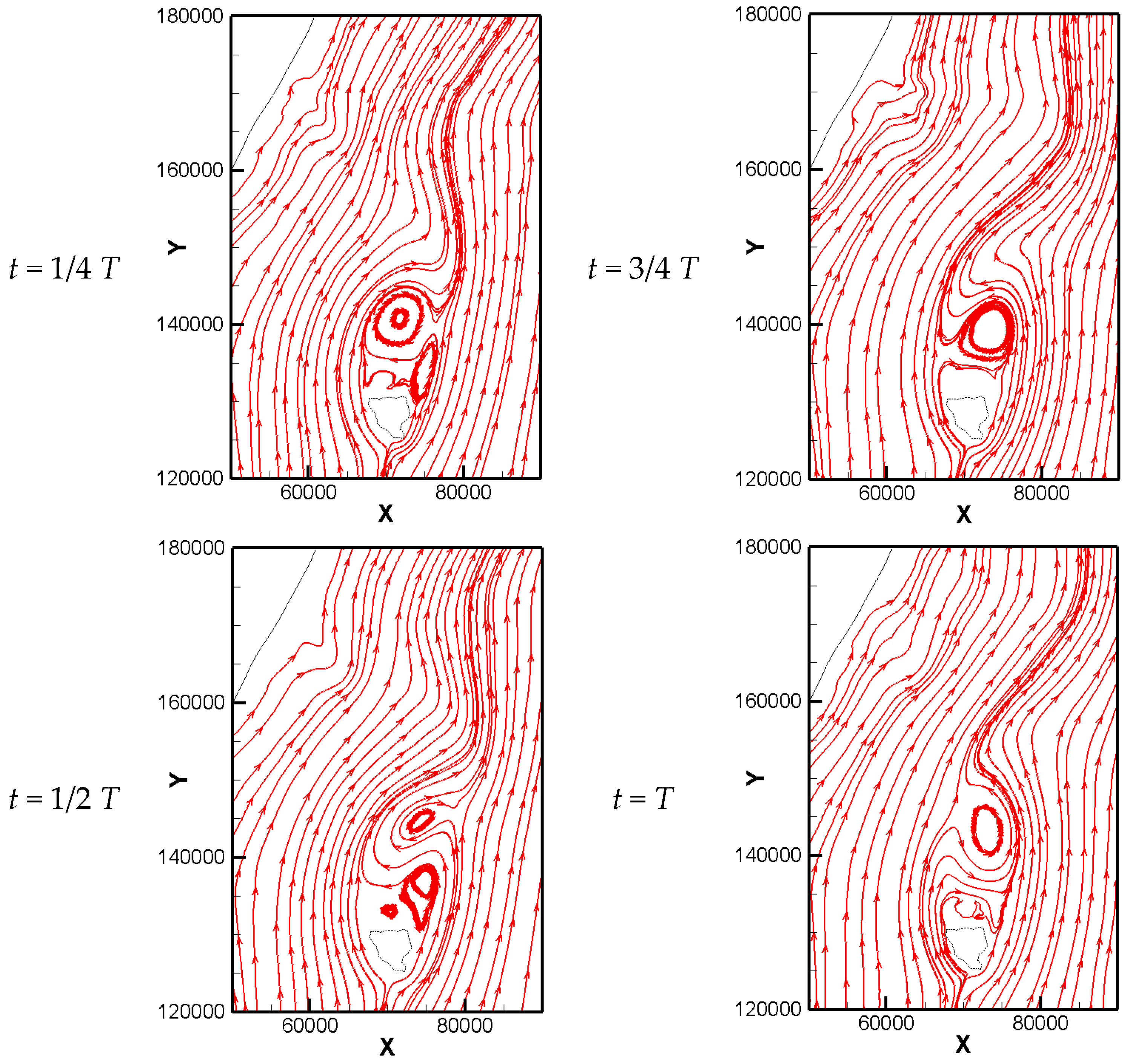
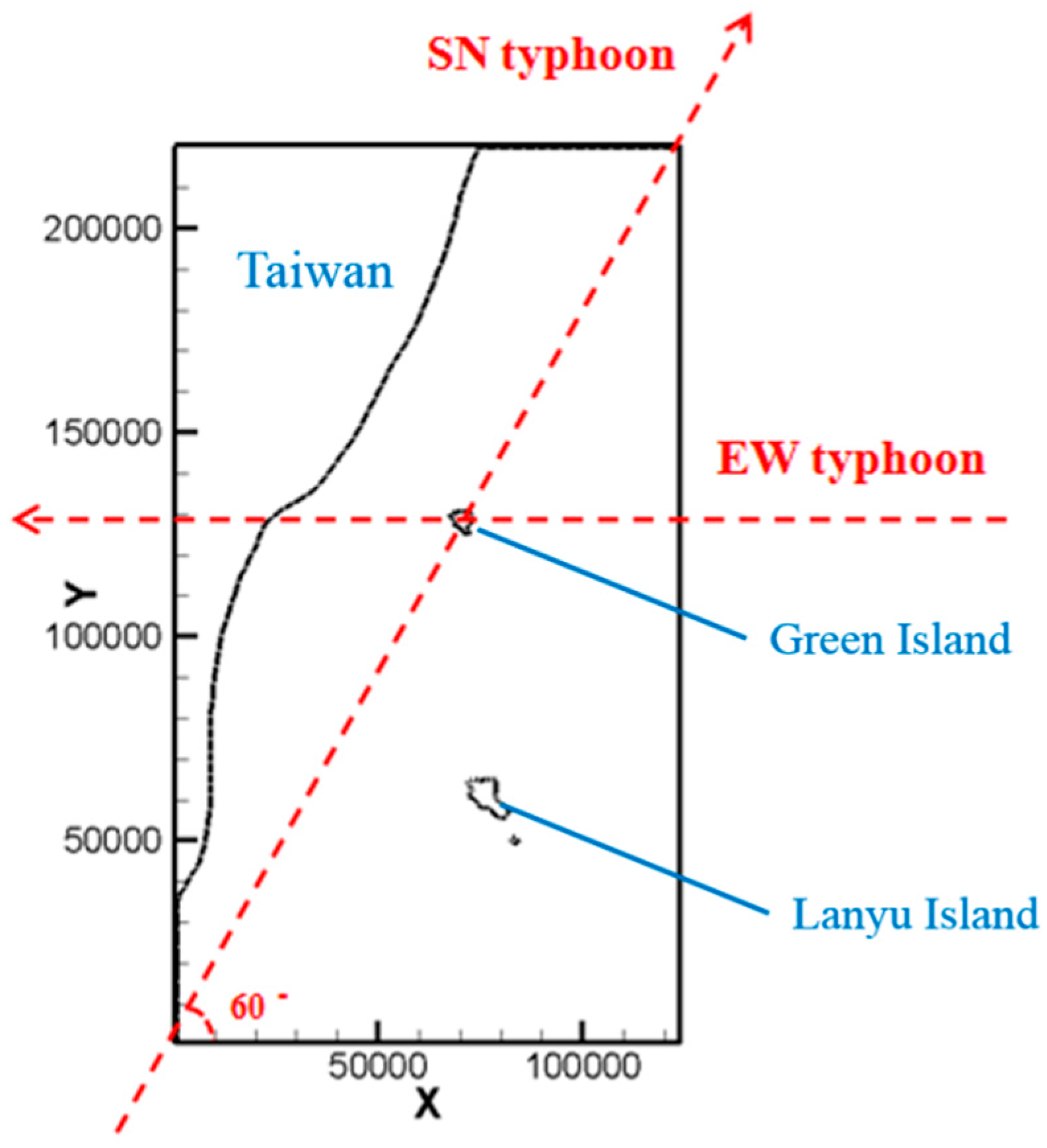
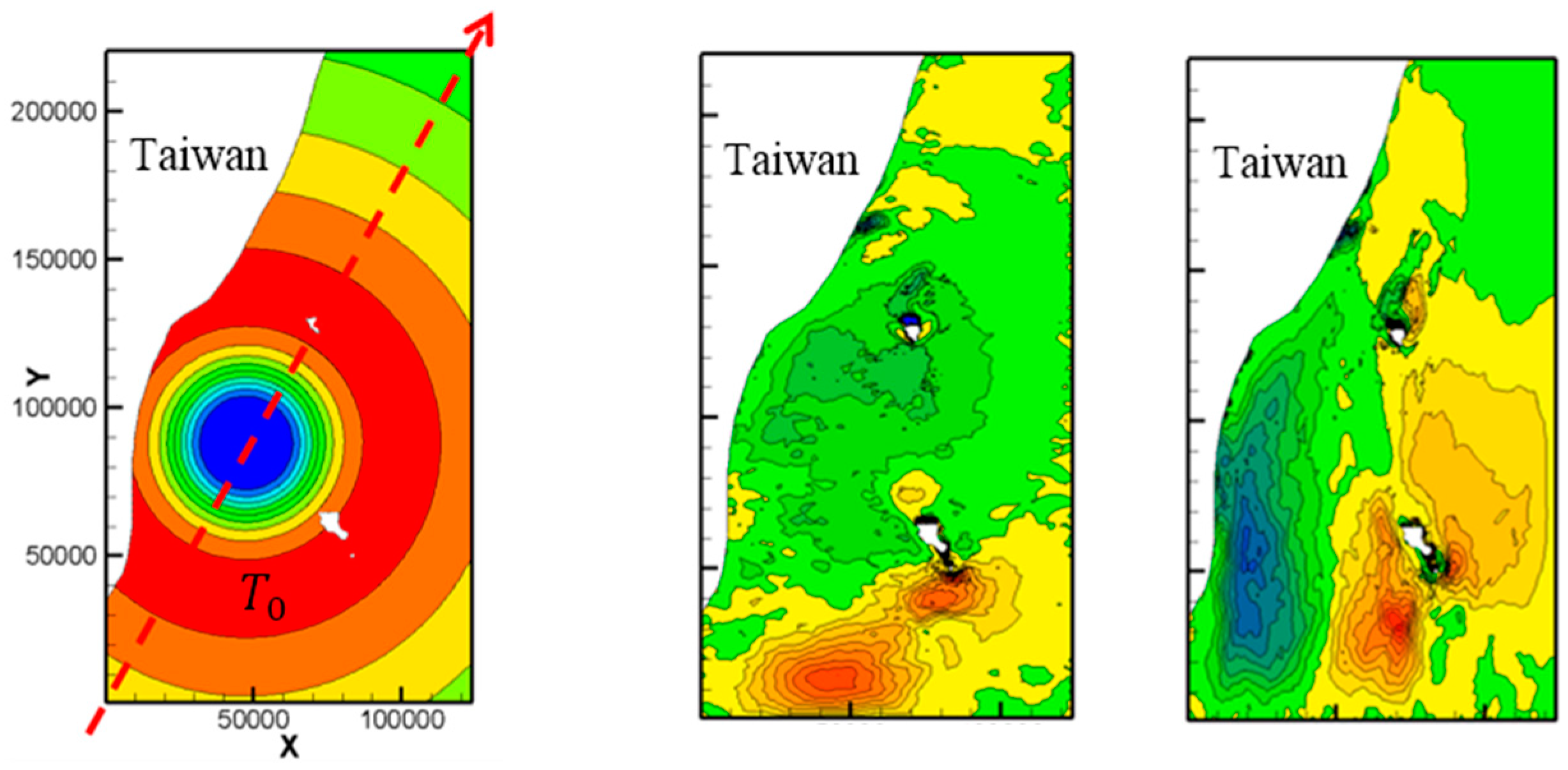

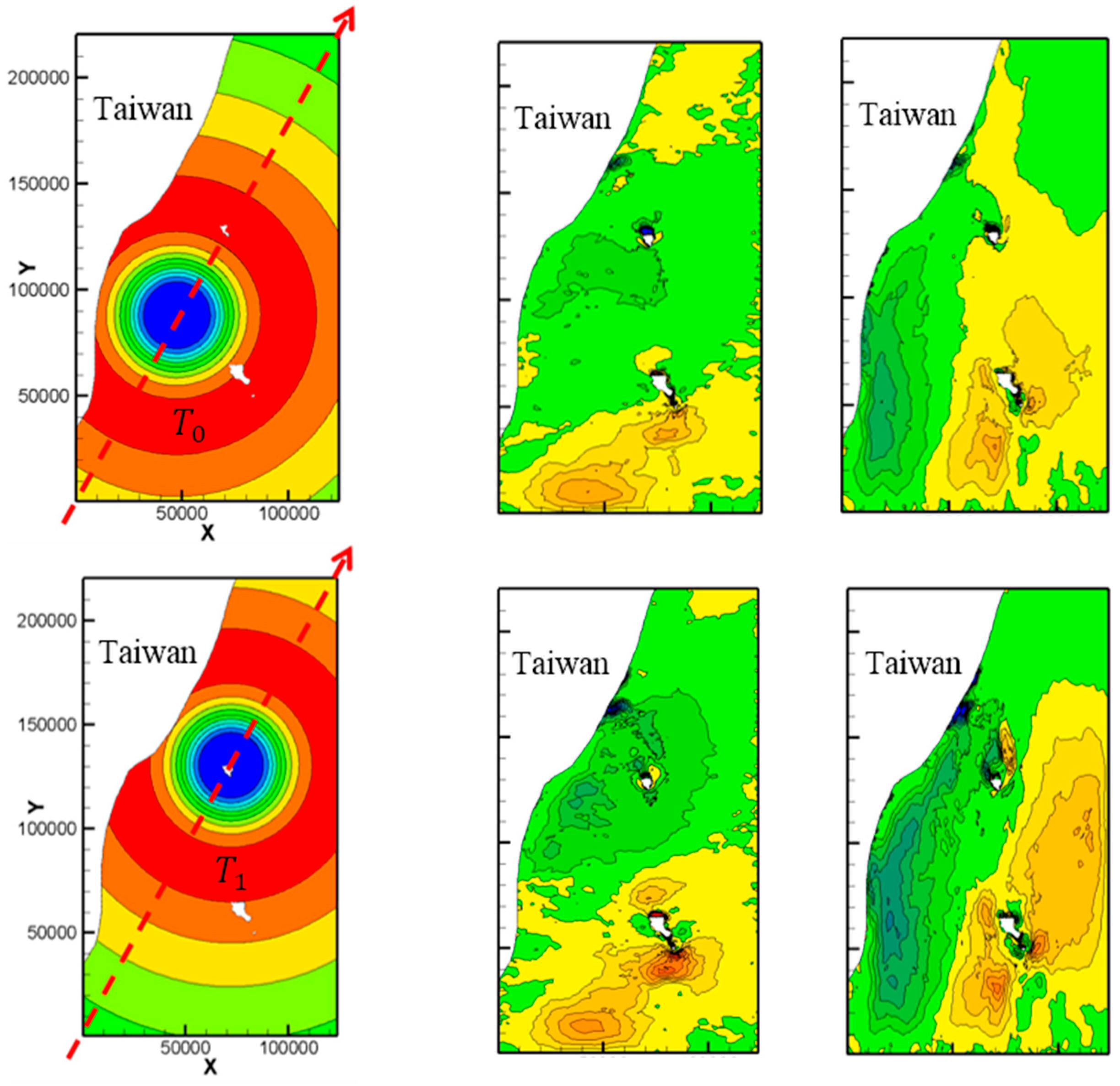
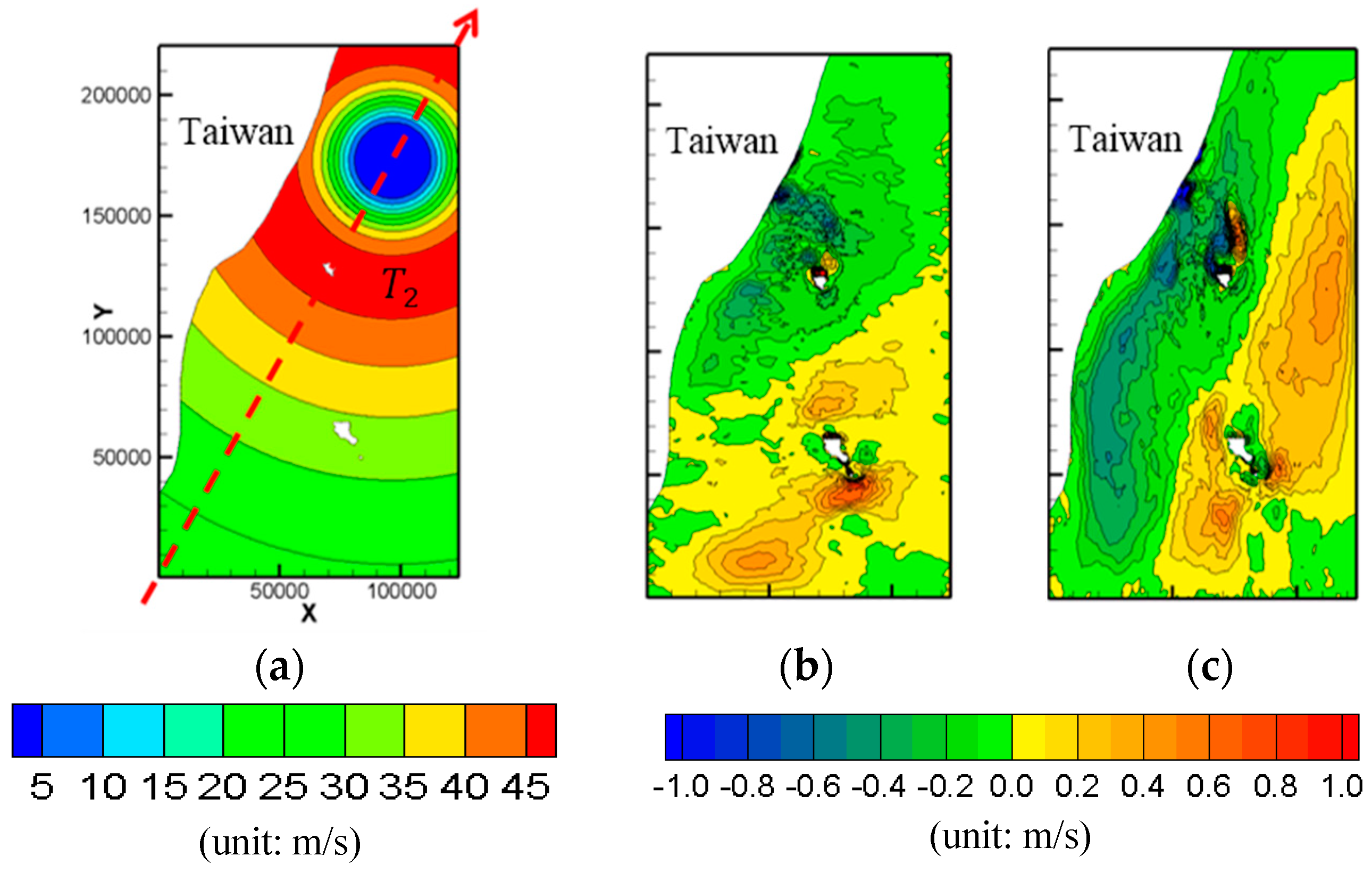


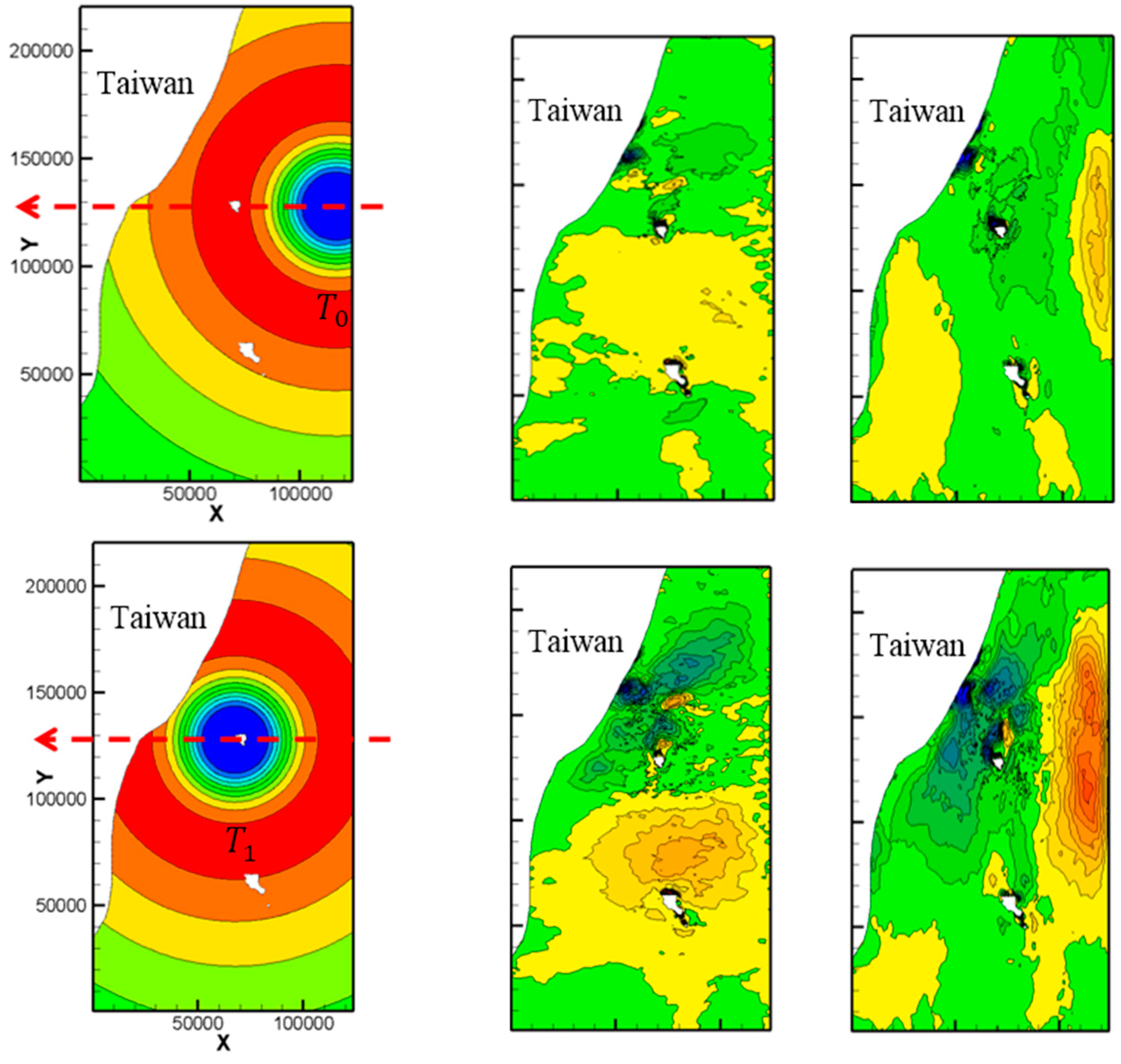


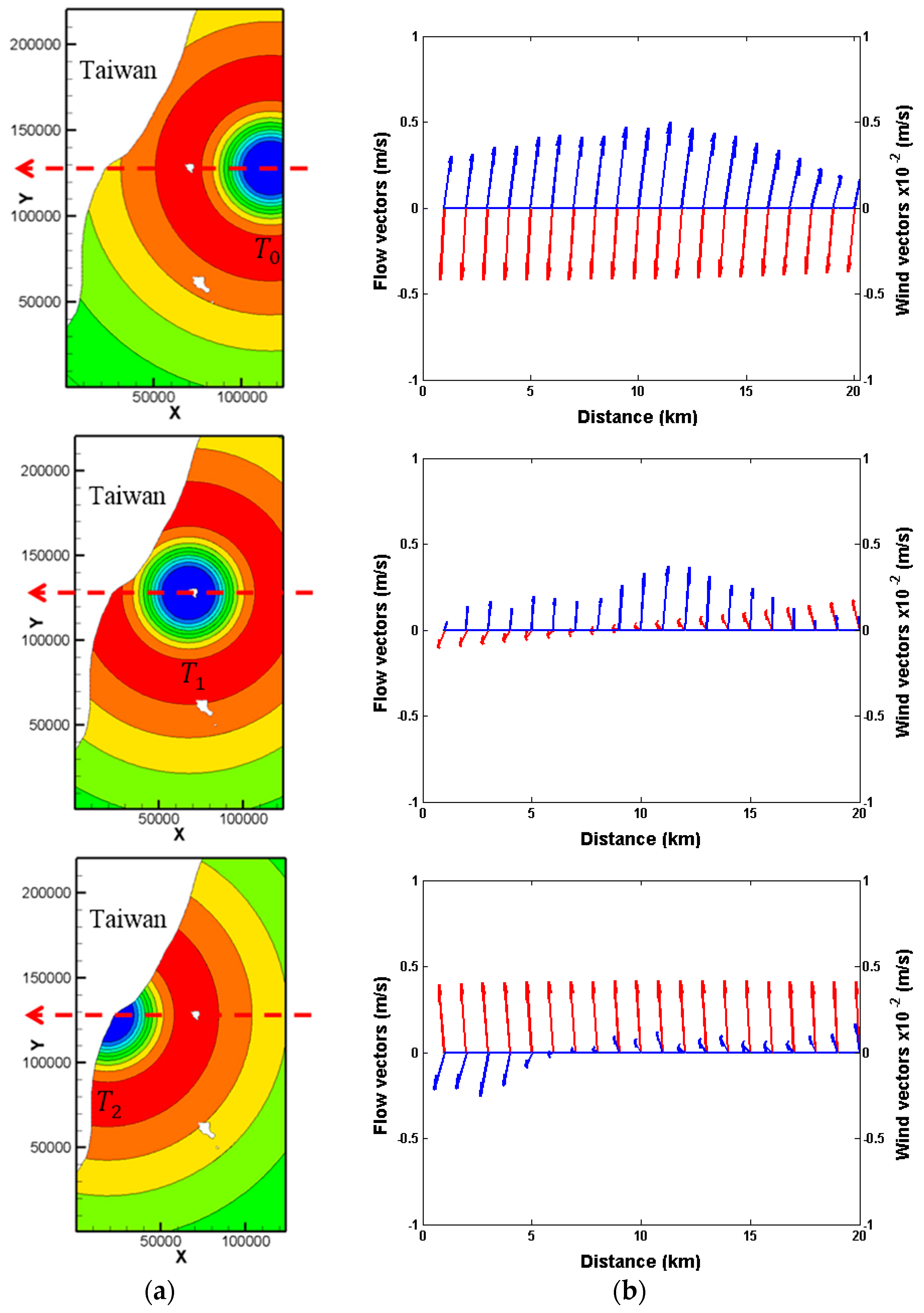

© 2018 by the authors. Licensee MDPI, Basel, Switzerland. This article is an open access article distributed under the terms and conditions of the Creative Commons Attribution (CC BY) license (http://creativecommons.org/licenses/by/4.0/).
Share and Cite
Hsu, T.-W.; Chou, M.-H.; Chao, W.-T.; Liang, S.-J. Typhoon Effect on Kuroshio and Green Island Wakes: A Modelling Study. Atmosphere 2018, 9, 36. https://doi.org/10.3390/atmos9020036
Hsu T-W, Chou M-H, Chao W-T, Liang S-J. Typhoon Effect on Kuroshio and Green Island Wakes: A Modelling Study. Atmosphere. 2018; 9(2):36. https://doi.org/10.3390/atmos9020036
Chicago/Turabian StyleHsu, Tai-Wen, Meng-Hsien Chou, Wei-Ting Chao, and Shin-Jye Liang. 2018. "Typhoon Effect on Kuroshio and Green Island Wakes: A Modelling Study" Atmosphere 9, no. 2: 36. https://doi.org/10.3390/atmos9020036





